Amistad National Recreation Area and its surroundings are in a transitional zone between eastern, western, northern, and southern avifaunas, which provides the opportunity to see a wide variety of birds. Over 200 species of birds, both resident and migratory, have been documented at the recreation area.
Introduction
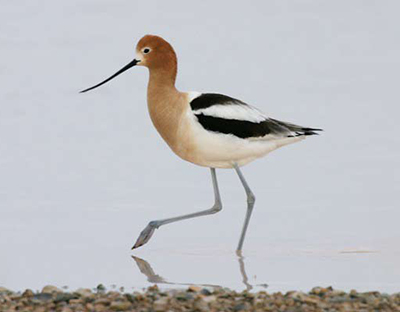
Photo © Robert Shantz
Hundreds of species of birds occur in the American Southwest, as do some of the best birdwatching opportunities. Birds are a highly visible component of many ecosystems. They are considered good indicators of ecosystem health because they can respond quickly to changes in resource conditions. Monitoring changes in bird population and community parameters can be an important component of any comprehensive, long-term monitoring program. Monitoring birds is especially critical given population declines for some species in recent decades, especially neotropical migratory birds. The Chihuahuan Desert Network (CHDN) will begin annual landbird monitoring at Amistad National Recreation Area (NRA) in 2010. However, a number of avian monitoring and survey projects have been conducted at the national recreation area in the past, with some continuing today. This overview discusses the birds of the national recreation area and some of the main monitoring/survey projects that have been conducted to date.
Amistad NRA is located along the Rio Grande in southwest Texas, approximately 6 miles (10 kilometers) northwest of Del Rio. The NRA’s southern boundary is located on the U.S./Mexico border, bounded by the Rio Grande. The national recreation area consists of 43,250 acres (17,503 hectares [ha]) of water and 14,042 acres (5,682 ha) of land in Val Verde County. The NRA includes more than 540 miles (868 kilometers [km]) of park boundary, and it extends 74 miles (119 km) up the Rio Grande, 14 miles (22 km) up the Pecos River, and 24 miles (38 km) up the Devils River. The national recreation area is located at the convergence of three ecoregional provinces, the Chihuahuan Desert, Edwards Plateau, and Tamaulipan Thornscrub. The geography of the area consists mainly of low hills and valleys near Amistad Dam, with steep-walled limestone canyons (up to about 200 feet [~60 meters] in height) upstream. Amistad NRA and its surroundings are in a transitional zone between eastern, western, northern, and southern avifaunas, which provides the opportunity to see a wide variety of birds. Over 200 species of birds, both resident and migratory, have been documented at the recreation area.
Resident Birds
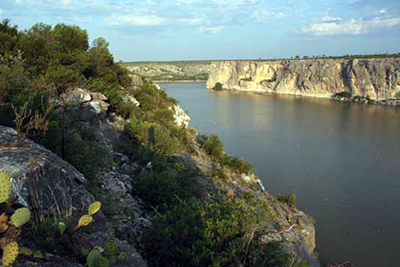
NPS Photo
One of the first efforts to study the birds of the Amistad Reservoir was that of LoBello (1976), whose observations were made primarily below the 1,144-foot (349-meter [m]) contour (the maximum flood stage of the reservoir). This 1,144-foot level also defines the approximate boundary of the NRA, except at developed sites. The purpose of the study was to determine what birds and other vertebrates inhabit the Lake Amistad area. Observations were made throughout the year at seven major study sites. One hundred and sixty-one species were recorded, with Passeriformes (e.g., the vermilion flycatcher [Pyrocephalus rubinus], cliff swallow [Petrochelidon pyrrhonota], and summer tanager [Piranga rubra]) comprising the majority of the list, followed by Anseriformes (e.g., green-winged teal [Anas carolinensis] and buffelhead [Bucephala albeola]), Falconiformes (e.g., osprey [Pandion haliaetus], Cooper’s hawk [Accipiter cooperii], and black hawk [Buteogallus athracinus]), and Charadriformes (e.g., killdeer [Charadrius vociferus] and least sandpiper [Erolia minutilla]).
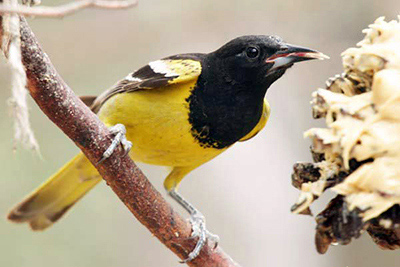
Photo © Robert Shantz
In a more recent effort to study the birds of Amistad NRA, birds were captured and banded in 2000-2002 during pre-breeding, breeding and migratory seasons (Larson 2004a, 2004b, and 2004c). The purpose of the effort was to provide baseline information on the presence of breeding and migratory birds and ascertain the importance of lands within the recreation area for birds (Larson 2004). In 2000, mist-netting was conducted at Lowry Springs (early May) and Satan Canyon (late May). In 2001, it was conducted at Oak Creek/277 North Campground (late March), Hunt Area 1 (early and late April), Satan Canyon (mid-April), and 277 North Campground (late April). In 2002, it was conducted at the Pecos River in May and October, and Satan Canyon in July. The results of the work are presented here for resident birds, and in a separate section for migratory birds. Winter or summer resident species recorded at the banding stations included: the spotted towhee (Pipilo maculatus), Lincoln’s sparrow (Melospiza lincolnii), chipping sparrow (Spizella passerina), vesper sparrow (Pooecetes gramineus), ruby-crowned kinglet (Regulus calendula), hermit thrush (Catharus guttatus), black-tailed gnatcatcher (Polioptila melanura), American goldfinch (Carduelis tristis), American robin (Turdus migratorius), common yellowthroat (Geothlypis trichas), red-winged blackbird (Agelaius phoeniceus), orchard oriole (Icterus spurius), Bell’s vireo (Vireo bellii), Bewick’s wren (Thryomanes bewickii), Northern cardinal (Cardinalis cardinalis), painted bunting (Passerina ciris), white-eyed vireo (Vireo griseus), golden-fronted woodpecker (Melanerpes aurifrons), black-crested titmouse (Baeolophus atricristatus), and pyrrhuloxia (Cardinalis sinuatus). The Scott’s oriole (Icterus parisorum), which has a limited range in central Texas, was observed at the Satan Canyon banding station.
Breeding Birds
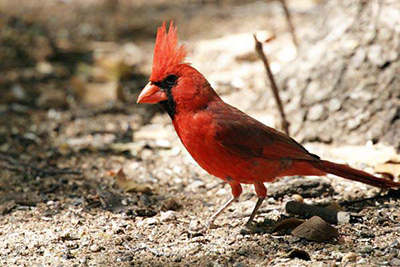
Photo © Robert Shantz
A five-year monitoring project of breeding birds was conducted at the national recreation area from 1998-2002. The project was part of the Monitoring Avian Productivity and Survivorship (MAPS) program, the objective of which is to contribute to an integrated avian population monitoring system for North America landbird species by providing annual regional indices and estimates for four population and demographic parameters (adult population size, post-fledging productivity, adult survivorship, and recruitment into the adult population; DeSante and O’Grady 2001). Under the program, sampling stations are established where researchers conduct constant-effort mist-netting and banding during the breeding season. At Amistad NRA, a sampling station was established below the Amistad Dam, about 15 miles (24 km) west of Del Rio, Texas. Twelve mist nets were used in Acacia minuta woodland habitats, although most nets were also relatively close (10 m) to herbaceous and shrubland habitats (Larson 2005).
A total of 61 species (32-41 per year) were captured over the five years, with a total of 2,198 individuals captured (257-561 individuals per year; Larson 2005). The number of species and the number of individuals captured were relatively high compared to MAPS stations nation-wide. The species caught in the highest numbers were Bewick’s wren, common ground dove (Columbina passerina), Northern cardinal, olive sparrow (Arremonops rufivirgatus), painted bunting, and yellow-breasted chat (Icteria virens). Two new breeding species were recorded for the recreation area, the Cooper’s hawk and yellow-billed cuckoo (Coccyzus americanus). There were fairly large fluctuations in both immature and adult bird species captured from year to year. For example, from 1999-2000, the number of immature birds increased for eight species and decreased for 15 species, while the number of adult birds increased for 30 species and decreased for 11 species. Climate fluctuations, such as in precipitation, are probably important drivers of bird productivity and presence (Larson 2005). The riparian corridor of the Rio Grande probably serves as a refuge for bird populations during drought events.
Migratory Birds
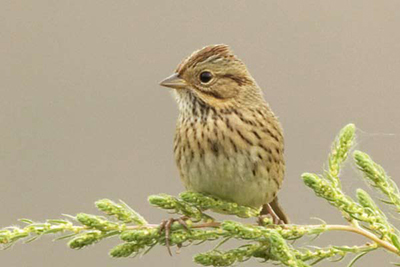
Photo © Robert Shantz
The conservation of migratory species proves more challenging than for other wildlife, because migratory birds have specific habitat requirements in breeding and wintering areas and they need migratory stopover sites. Migratory species migrate thousands of miles and cross international borders, where protection may vary, to reach breeding and wintering habitat.
As described in the Resident Bird section, birds were captured and banded at Amistad NRA in 2000-2002 during migratory and breeding seasons (Larson 2004a, 2004b, and 2004c). Sampling locations and months were discussed previously. Migratory species captured in late March to May in one or more of the years included the clay-colored sparrow (Spizella pallida), ruby-throated hummingbird (Archilochus colubris), American redstart (Setophaga ruticilla), yellow warbler (Dendroica petechia), orange-crowned warbler (Vermivora celata), Nashville warbler (Vermivora ruficapilla), a number of Lincoln’s sparrows (Melospiza lincolnii), Wilson’s warbler (Wilsonia pusilla), MacGillivray’s warbler (Oporornis philadelphia), black-and-white warbler (Mniotilta varia), worm-eating warbler (Helmitheros vermivorus), and winter wren (Troglodytes troglodytes). Those caught during banding at the river in October (confirming that fall migrants use the river corridor as a migration route) included the clay-colored sparrow, least flycatcher (Empidonax minimus), Lincoln’s sparrow, Nashville warbler, orange-crowned warbler, and Wilson’s warbler. Also, eight new migratory species were recorded for Amistad NRA during the MAPS project; these included the indigo bunting (Passerina cyanea), Western tanager (Piranga ludoviciana), and Swainson’s thrush (Catharus ustulatus) (Larson 2005).
Endangered and Threatened Species
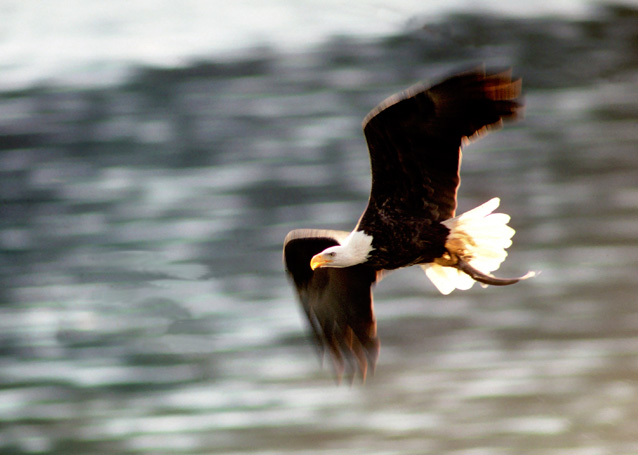
Photo by Rob Bennetts
Five bird species that are known to occur at Amistad NRA are federally- and/or state-listed as endangered or threatened. The interior least tern (Sterna antillarum athaloassos) is federally- and state-listed, and the bald eagle (Haliaeetus leucocephalus), brown pelican (Pelecanus occidentalis), peregrine falcon (Falco peregrinus anatum), and white-faced ibis (Plegadis chihi) are state-listed as endangered or threatened. The brown pelican, bald eagle, and peregrine falcon were also federally-listed until recently (i.e., 2009, 2007, and 1999, respectively).
The interior least tern occurs at Amistad NRA from late April to August and has been known to breed at the reservoir since 1989; this species is discussed in greater detail below. The bald eagle occurs at Amistad during winter months and is considered a rare to occasional winter visitor (National Park Service [NPS]-CHDN 2010; Amistad NRA Bird List 2010). The brown pelican may occur at the recreation area during post-breeding dispersal and winter months and is considered a rare to occasional visitor (NPS-CHDN 2010; Amistad NRA Bird List 2010). The peregrine falcon is a rare visitor, but may occur in the general vicinity during the spring or fall (Texas Natural Heritage Program [TNHP] 1995; Amistad NRA Bird List 2010). The white-faced ibis is uncommon, but may visit the area in late summer and fall (TNHP 1995; Amistad NRA Bird List 2010).
Individual Species Studies or Surveys
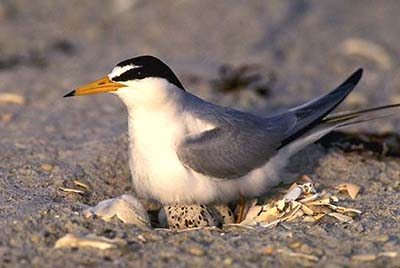
USFWS Photo
The interior least tern is a small (8-9 inches [20.3-22.9 centimeters]) shorebird— the smallest North American tern. It breeds in isolated areas along the Missouri, Mississippi, Colorado, Arkansas, Red, and Rio Grande river systems. The species is migratory and winters along coastal areas of Central and South America. It has been federally-listed since 1985. In Texas, the interior least tern is found at three reservoirs along the Rio Grande (including Amistad) and along the Canadian River, Prairie Dog Town Fork of the Red River, and Red River. From late April to August, terns use barren to sparsely vegetated sandbars along rivers, sand and gravel pits, or lake and reservoir shorelines. Preferred nesting habitat is found on islands with no vegetation or fire ants; these habitats occur duringspring draw down of the reservoir, when islands become exposed.
Annual surveys have been conducted at Amistad NRA for the interior least tern every year since 1985. Surveys are conducted at the reservoir (U.S. and, sometimes, Mexico sides) in locations such as Devils River, Rio Grande, Castle Canyon, and San Pedro Canyon/Islands. Surveys in earlier years were conducted in the April to June time frame, while more recent surveys have been conducted within a 2-3 week window in late June and early July (Lott 2006) to coincide with surveys of the species in other areas. Currently, biologists at the NRA also survey and monitor the birds throughout the entire period that the terns occur at the park unit. Birds in flight, foraging, and/or on nesting islands are recorded. The number of birds counted during the surveys varies, with as many as 344 interior least terns (adults, juveniles, and chicks on both U.S. and Mexico sides) recorded in July of 2001 (172 birds on each side of the border). Each survey provides an annual count of the total number of adult birds present at the time of the survey, which can be used as an index of the adult population over time. The number of active nests and/or incubating adults may also be counted. The greatest number of interior least terns that have been counted at one time on the U.S. side in the April-May 2010 time frame is 59 adult terns; no surveys are being conducted on the Mexico side in 2010.
During surveys for interior least terns, other birds observed were also recorded. A list of these birds includes over 30 species, including the forster’s tern (Sterna forsteri), black tern (Chlidonias niger), Caspian tern (Hydroprogne caspia), neotropic cormorant (Phalacrocorax brasilianus), laughing gull (Leucophaeus atricilla), black-necked stilt (Himantopus mexicanus), American avocet (Recurvirostra americana), least sandpiper (Calidris minutilla), spotted sandpiper (Actitis macularius), great blue heron (Ardea herodias), green heron (Butorides virescens), American white pelican (Pelecanus erythrorhynchos), redhead duck (Aythya americana), lesser scaup (Aythya affinis), and osprey (Pandion haliaetus).
Surveys for snowy plovers (Charadrius alexandrinus) were conducted several times (in May-July of 2000-2002) at various locations on both the U.S. and Mexico sides of the reservoir. The number of adults, juveniles, and chicks were recorded, with the highest number being 26 adults and chicks on both sides of the reservoir.
Summary
Description and results of a number of surveys and studies of Amistad NRA’s birds have been discussed here. Other bird surveys/studies have been or are being conducted at the recreation area. Additional information can be obtained on the park (URL: https://www.nps.gov/amis/naturescience/birds.htm) and Science of the American Southwest (URL: https://www.nps.gov/subjects/swscience) websites. Also, landbird monitoring will be conducted annually at Amistad NRA beginning in 2010. As part of the CHDN Inventory & Monitoring program, birds will be monitored during the breeding season. Data will be used to estimate occupancy, species richness and composition, and density (when feasible). The work done so far at Amistad, which recorded a high diversity of species and bird numbers, has shown the riparian habitat along the Rio Grande is of high significance for avian species (Larson 2005; Larson 2004a, 2004b, 2004c).
Literature Cited
DeSante, D.E., and D.R. O’Grady. 2001. The Monitoring Avian Productivity and Survivorship (MAPS) Program 1997 and 1998 report. Bird Populations 5:49-101.
Larson, D.H. 2004a. 2000 Bird migration report for Amistad National Recreation Area. April 2004. National Park Service.
Larson, D.H. 2004b. 2001 Bird banding report for Amistad National Recreation Area. April 2004. National Park Service.
Larson, D.H. 2004c. 2002 Bird banding report for Amistad National Recreation Area. April 2004. National Park Service.
Larson, D.H. 2005. Summary Report of the Amistad National Recreation Area MAPS Project for 1998-2002. National Park Service.
LoBello, R.L. 1976. Vertebrates of the Lake Amistad National Recreation Area, Texas. M.S. Thesis, Sul Ross State University.
Lott, C.A. 2006. Distribution and abundance of the interior population of the least tern (Sternula antillarum), 2005. A review of the first complete range-wide survey in the context of historic and ongoing monitoring efforts. Prepared for U.S. Army Corps of Engineers. ERDC/EL TR-06-13.
National Park Service, Chihuahuan Desert Inventory & Monitoring Network (NPS-CHDN). 2010. Chihuahuan Desert Network vital signs monitoring plan. Natural Resource Report NPS/CHDN/NRR-2010/188. National Park Service, Fort Collins, Colorado.
Texas Natural Heritage Program. 1995. Biological survey of Lake Amistad Recreation Site. Final Report to the U.S. Air Force. Texas Natural Heritage Program, Texas Parks and Wildlife Department, Austin, Texas.
Prepared by Patty Valentine-Darby, Chihuahuan Desert Network Inventory & Monitoring Program, 2012.
Last updated: October 1, 2018
